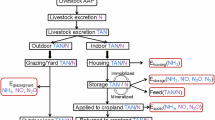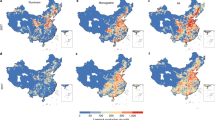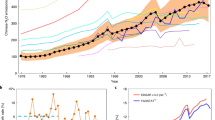Abstract
Livestock production in China is increasingly located near urban areas, exposing human populations to nitrogen pollution via air and water. Here we analyse livestock and human population data across 2,300 Chinese counties to project the impact of alternative livestock distributions on nitrogen emissions. In 2012 almost half of China’s livestock production occurred in peri-urban regions, exposing 60% of the Chinese population to ammonia emissions exceeding UN guidelines. Relocating 5 billion animals by 2050 according to crop–livestock integration criteria could reduce nitrogen emissions by two-thirds and halve the number of people exposed to high ammonia emissions. Relocating 10 billion animals away from southern and eastern China could reduce ammonia exposure for 90% of China’s population. Spatial planning can therefore serve as a powerful policy instrument to tackle nitrogen pollution and exposure of humans to ammonia.
This is a preview of subscription content, access via your institution
Access options
Access Nature and 54 other Nature Portfolio journals
Get Nature+, our best-value online-access subscription
$32.99 / 30 days
cancel any time
Subscribe to this journal
Receive 12 digital issues and online access to articles
$119.00 per year
only $9.92 per issue
Buy this article
- Purchase on SpringerLink
- Instant access to full article PDF
Prices may be subject to local taxes which are calculated during checkout





Similar content being viewed by others
Data and materials availability
All data needed to evaluate the conclusions in the paper are present in the paper and/or the Supplementary Materials.
References
Wu, Y. et al. PM2.5 pollution is substantially affected by ammonia emissions in China. Environ. Pollut. 218, 86–94 (2016).
Liu, M. et al. Ammonia emission control in China would mitigate haze pollution and nitrogen deposition, but worsen acid rain. Proc. Natl Acad. Sci. USA 116, 7760–7765 (2019).
Yu, C. et al. Managing nitrogen to restore water quality in China. Nature 567, 516–520 (2019).
Gu, B. et al. Integrated reactive nitrogen budgets and future trends in China. Proc. Natl Acad. Sci. USA 112, 8792–8797 (2015).
Bai, Z. et al. China’s livestock transition: driving forces, impacts, and consequences. Sci. Adv. 4, eaar8534 (2018).
Jin, X. et al. Spatial planning needed to drastically reduce nitrogen and phosphorus surpluses in China’s agriculture. Environ. Sci. Technol. 4, 11894–11904 (2020).
Jin, S. et al. Decoupling livestock and crop production at the household level in China. Nat. Sustain. 4, 48–55 (2021).
Zhang, C. et al. Rebuilding the linkage between livestock and cropland to mitigate agricultural pollution in China. Resour. Conserv. Recycl. 144, 65–73 (2019).
Gerber, P. et al. Geographical determinants and environmental implications of livestock production intensification in Asia. Bioresour. Technol. 96, 263–276 (2005).
Wei, S. et al. Environmental, economic and social analysis of peri-urban pig production. J. Cleaner Prod. 129, 596–607 (2016).
Uwizeye, A. et al. Nitrogen emissions along global livestock supply chains. Nat. Food 1, 437–446 (2020).
Bai, Z. et al. Nitrogen, phosphorus, and potassium flows through the manure management chain in China. Environ. Sci. Technol. 24, 13409–13418 (2016).
Wang, M. et al. Hotspots for nitrogen and phosphorus losses from food production in China: a county-scale analysis. Environ. Sci. Technol. 52, 5782–5791 (2018).
Lassaletta, L. et al. Future global pig production systems according to the Shared Socioeconomic Pathways. Sci. Total Environ. 665, 739–751 (2019).
Ma, L. et al. Exploring future food provision scenarios for China. Environ. Sci. Technol. 53, 1385–1393 (2019).
Hu, Y. et al. Food production in China requires intensified measures to be consistent with national and provincial environmental boundaries. Nat Food 1, 572–582 (2020).
Bradford, M. A., Fierer, N. & Reynolds, J. F. Soil carbon stocks in experimental mesocosms are dependent on the rate of labile carbon, nitrogen and phosphorus inputs to soils. Funct. Ecol. 22, 964–974 (2008).
Reijnders, L. Phosphorus resources, their depletion and conservation, a review. Resour. Conserv. Recycl. 93, 32–49 (2014).
Liu, Q. et al. Global animal production and nitrogen and phosphorus flows. Soil Res. 55, 451–462 (2017).
Willems, J. et al. Why Danish pig farms have far more land and pigs than Dutch farms? Implications for feed supply, manure recycling and production costs. Agric. Syst. 144, 122–132 (2016).
Swaney, D. P., Howarth, R. W. & Hong, B. County, subregional and regional nitrogen data derived from the Net Anthropogenic Nitrogen Inputs (NANI) toolbox. Data Brief 18, 1877–1888 (2018).
Delgado, C. L. et al. Determinants and Implications of the Growing Scale of Livestock Farms in Four Fast-Growing Developing Countries Report No. 157 (International Food Policy Research Institute, 2008).
Steinfeld, H. et al. Livestock in a Changing Landscape, vol. 1: Drivers, Consequences, and Responses (Island Press, 2013).
Błażejczyk-Majka, L. & Radosław, K. A. L. A. Concentration and productivity of livestock and mixed farms in new and old EU member states. A regional level approach. J. Cent. Eur. Agric. 16, 159–176 (2015).
Drabenstott, M., Henry, M. & Mitchell, K. Where have all the packing plants gone? The new meat geography in rural America. Economet. Rev. 84, 65–82 (1999).
Donham, K. J. The concentration of swine production: effects on swine health, productivity, human health, and the environment. Vet. Clin. North Am. Food Anim. Pract. 16, 559–597 (2000).
Li, T. et al. All-cause mortality risk associated with long-term exposure to ambient PM2.5 in China: a cohort study. Lancet Public Health 3, e470–e477 (2018).
Zhao, H. et al. China’s future food demand and its implications for trade and environment. Nat. Sustain. 4, 1042–1051 (2021).
The Zero Increase of Fertilizer and Pesticides Action (Ministry of Agricultural and Rural Affairs, 2015); http://www.moa.gov.cn/nybgb/2015/san/201711/t20171129_5923401.htm
Statistical Databases (FAO, 2021); http://www.fao.org/faostat/en/
Chen, X. et al. Producing more grain with lower environmental costs. Nature 514, 486–489 (2014).
Cui, Z. et al. Pursuing sustainable productivity with millions of smallholder farmers. Nature 555, 363–366 (2018).
Chadwick, D. et al. Strategies to reduce nutrient pollution from manure management in China. Front. Agric. Sci. Eng. 7, 45–55 (2020).
Sachs, J. et al. Sustainable Development Report 2020: The Sustainable Development Goals and COVID-19 (Cambridge Univ. Press, 2020).
Bai, Z. et al. Socio-economic drivers of pig production and their effects on achieving sustainable development goals in China. J. Integr. Environ. Sci. 16, 141–155 (2019a).
Bai, Z. et al. China’s pig relocation in balance. Nat. Sustain. 2, 888–888 (2019b).
Hou, Y., Oenema, O. & Zhang, F. Integrating crop and livestock production systems—towards agricultural green development. Front. Agric. Sci. Eng. 8, 1–14 (2021).
Franzluebbers, A. et al. Integrated crop–livestock systems: lessons from New York, British Columbia, and the south-eastern United States. Front. Agric. Sci. Eng. 8, 81–96 (2021).
Van Grinsven, H. J. et al. Potential of extensification of European agriculture for a more sustainable food system, focusing on nitrogen. Environ. Res. Lett. 10, 025002 (2015).
Van Grinsven, H. J. et al. Reducing external costs of nitrogen pollution by relocation of pig production between regions in the European Union. Reg. Environ. Change 18, 2403–2415 (2018).
Erisman, J. W. Setting ambitious goals for agriculture to meet environmental targets. One Earth 4, 15–18 (2021).
Bai, Z. et al. Impacts of African swine fever on water quality in China. Environ. Res. Lett. 16, 054032 (2021).
Foley, M. M. et al. Guiding ecological principles for marine spatial planning. Mar. Policy 34, 955–966 (2010).
Li, X. et al. Perspectives on livestock production systems in China. Rangeland J. 30, 211–220 (2008).
Wang, H. et al. Producing and procuring horticultural crops with Chinese characteristics: the case of northern China. World Dev. 37, 1791–1801 (2009).
Ti, C. et al. Potential for mitigating global agricultural ammonia emission: a meta-analysis. Environ. Pollut. 245, 141–148 (2019).
Sha, Z. et al. Improved soil–crop system management acids in NH3 emission mitigation in China. Environ. Pollut. 289, 117844 (2021).
Zhang, X. et al. Societal benefits of halving agricultural ammonia emissions in China far exceed the abatement costs. Nat. Commun. 11, 4357 (2020).
Giannakis, E., Kushta, J., Bruggeman, A. & Lelieveld, J. Costs and benefits of agricultural ammonia emission abatement options for compliance with European air quality regulations. Environ. Sci. Eur. 31, 1–13 (2019).
Wang, S. et al. Urbanization can benefit agricultural production with large-scale farming in China. Nat. Food 2, 183–191 (2021).
Zhang, T. et al. Replacing synthetic fertilizer by manure requires adjusted technology and incentives: a farm survey across China. Resour. Conserv. Recycl. 168, 105301 (2021).
Tan, M. et al. Operational costs and neglect of end-users are the main barriers to improving manure treatment in intensive livestock farms. J. Cleaner Prod. 289, 125149 (2021).
National Data (National Bureau of Statistics of China); http://www.stats.gov.cn/
Acknowledgements
This work was supported by the Nature Science Foundation of China (31872403, 32002138, 71961137011, 31801941, 31972517); the Youth Innovation Promotion Association, Chinese Academy of Sciences (2019101); the National Social Science Fund of China (20BZZ040); Key Laboratory of Agricultural Water Resources-CAS (ZD201802); the Outstanding Young Scientists Project of Natural Science Foundation of Hebei (C2019503054); Key R&D Program of Hebei (21327507D); Hebei Dairy Cattle Innovation Team of Modern Agro-industry Technology Research System HBCT2018120206. Z.B. thanks the FABLE Consortium, Food and Land Use (FOLU) Coalition and the Norwegian Climate and Forest Initiative (NICFI). This publication contributes to UNCNET, a project funded under the JPI Urban Europe/China collaboration (870234, FFG, Austria).
Author information
Authors and Affiliations
Contributions
All authors contributed equally to the design, implementation, and analysis of this study.
Corresponding authors
Ethics declarations
Competing interests
The authors declare no competing interests.
Peer review
Peer review information
Nature Food thanks Xuejun Liu and the other, anonymous, reviewer(s) for their contribution to the peer review of this work.
Additional information
Publisher’s note Springer Nature remains neutral with regard to jurisdictional claims in published maps and institutional affiliations.
Extended data
Extended Data Fig. 1 Contribution of each counties group to total livestock population (a), manure nitrogen (N) excretions, synthetic fertilizer N application (c) and N surplus of cropland (d) according to their livestock density in 1990, 2012 and different scenarios in 2050. Level represents the livestock density, in LU ha-1.
Note: BAU is business as usual scenario which follows the SSP2 storyline; SNT, is south to north transfer of pig production scenario; ITI is the integrated technology improvement scenario; SP-NH3 is livestock spatial planning with NH3 criteria scenario; and SP-CLI is livestock spatial planning with crop–livestock integration criteria.
Extended Data Fig. 2
Ratio of livestock manure N excretions and crop N uptake at county level in 1992 (a) and 2012 (b), and ratio of synthetic fertilizer N input and crop N uptake at county level in 1992 (c) and 2012 (d).
Extended Data Fig. 3
Mapping the manure N and crop N ratio in United States in 1992 (a) and 2012 (b), and synthetic fertilizer use in 1992 (c) and 2012 (d).
Extended Data Fig. 4
Spatial distributions of the correlation coefficients of the annual mean PM2.5 concentration in the air and total synthetic fertilizer N use per county level (a), of the PM2.5 concentration with total livestock N excretion (b), with annual mean NOX concentration in air (c), with annual mean SO2 concentration in air (d), with annual mean air temperature (e) and with annual mean wind speed (f) to in China in 2012. Note: value indicates the slope of simulated correlations (regression coefficients), while the significance was represents by color.
Extended Data Fig. 5 Ammonia emissions from the food system (a), and manure N surplus due to uneven distribution of crop–livestock production when considering the bioavailability of manure N as criterion for estimating the N surplus in 1990, 2012 and for different scenarios in 2050.
Note: Definition of scenarios see Extended Data Fig. 1. The bioavailability of different organic resources under improved management see Jin et al., 2020.
Extended Data Fig. 6 Illustration of the relocation of livestock following the optimization of livestock spatial planning scenarios – SP-NH3 in 2050.
Arrows indicate the likely movement of animals from southeast to west and northwest, mainly via shutdown farms in the move out regions and build new farms in the move in regions.
Extended Data Fig. 7 Illustration of the relocation of livestock following within or outside of the provincial border under the livestock spatial planning scenarios – SP-NH3 (a) and SP-CLI (b) in 2050.
Note: Definition of scenarios see Extended Data Fig. 1.
Extended Data Fig. 8 Illustration of the relocation of livestock following the optimization of livestock spatial planning scenarios – SP-CLI in 2050.
Note: Arrows indicate the likely movement of animals from southeast to west and northwest, mainly via shutdown farms in the move out regions and build new farms in the move in regions.
Extended Data Fig. 9 County level information about total livestock unit in the business as usual (BAU) scenario (a), south-north transfer of pig production (SNT) scenario (b) and spatial planning under the NH3 emission criteria (SP-NH3) scenario (c), and spatial planning under the crop–livestock integration scenario (SP-CLI) in 2050.
Note: Definition of scenarios see Extended Data Fig. 1.
Extended Data Fig. 10
Short-term changes of livestock production distribution between 2012 and 2017, and expansion plan of top pig production companies in 2020.
Supplementary information
Supplementary Information
Supplementary methods and discussion, Figures 1–10 and Tables 1 and 2.
Rights and permissions
About this article
Cite this article
Bai, Z., Fan, X., Jin, X. et al. Relocate 10 billion livestock to reduce harmful nitrogen pollution exposure for 90% of China’s population. Nat Food 3, 152–160 (2022). https://doi.org/10.1038/s43016-021-00453-z
Received:
Accepted:
Published:
Issue date:
DOI: https://doi.org/10.1038/s43016-021-00453-z
This article is cited by
-
Managing nitrogen to achieve sustainable food-energy-water nexus in China
Nature Communications (2025)
-
Dietary changes are associated with an increase in air pollution-related health and environmental inequity in China
Communications Earth & Environment (2025)
-
Co-benefits for cropland yield, nitrogen emissions, and climate impact through multi-objective optimization agricultural manure solutions
Nature Communications (2025)
-
Reactive Nitrogen from Agriculture: A Review of Emissions, Air Quality, and Climate Impacts
Current Pollution Reports (2025)
-
Holistic food system innovation strategies can close up to 80% of China’s domestic protein gaps while reducing global environmental impacts
Nature Food (2024)



